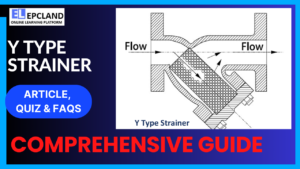Valve Stem Sealing: Critical Insights from 10 Essential Questions
Piping engineering involves understanding the intricate details of components like valves. While some valve parts are designed to withstand significant internal pressure, others, particularly those around the stem, play a crucial, albeit different, role. Valve Stem Sealing is paramount for preventing leaks, ensuring smooth operation, and minimizing environmental emissions. This guide dives into the non-pressure retaining parts responsible for this critical function, exploring their purpose, materials, and maintenance needs through a series of essential questions based on expert knowledge. Proper Valve Stem Sealing isn’t just about efficiency; it’s vital for plant safety and environmental compliance.
Table of Contents
- Introduction
- Check the complete course on Piping Engineering
- The Quiz Section: Test Your Knowledge on Valve Stem Sealing
- Explore all available courses on EPCLAND
- Major Takeaways
- Conclusion
- Check all Quiz Blogs with Video Explanations
🔷 Check the complete course on Piping Engineering
The Quiz Section: Test Your Knowledge on Valve Stem Sealing
Question 1: Which of the following is considered a non-pressure retaining part crucial for valve stem sealing?
Question 2: What is the primary function of the gland flange in a valve’s stem sealing mechanism?
Question 3: The gland sleeve or gland bush serves what main purpose?
Question 4: What is the actual sealing element used to prevent leakage along the valve stem?
Question 5: Which materials are commonly used for gland packing?
Question 6: How is proper compression of gland packing typically adjusted?
Question 7: What happens if the gland packing compression is too loose?
Question 8: What potential issue arises if the gland packing compression is too tight?
Question 9: The space housing the gland packing around the valve stem is known as the:
Question 10: Why is the proper monitoring and maintenance of gland packing especially important in process plants?
📘 Explore all available courses on EPCLAND
Major Takeaways
- Non-pressure retaining parts around the valve stem are essential for Valve Stem Sealing and smooth operation.
- The stuffing box provides the designated space for the gland packing responsible for Valve Stem Sealing.
- Gland packing is the primary sealing element, preventing leakage along the stem and is key to effective Valve Stem Sealing.
- Gland packing is typically made from materials like graphite or PTFE, selected based on service conditions for reliable Valve Stem Sealing.
- Proper compression of gland packing is critical for effective Valve Stem Sealing; too loose causes leaks, too tight causes friction and potential damage.
- Monitoring and maintaining gland packing is vital in process plants to reduce fugitive emissions associated with inadequate Valve Stem Sealing.
Conclusion
Understanding the non-pressure retaining components around the valve stem is fundamental to effective Valve Stem Sealing. The gland flange, gland sleeve, gland packing, and stuffing box work together to create a reliable seal, prevent leaks, ensure smooth operation, and significantly reduce fugitive emissions. Regular inspection and maintenance of these parts are crucial for maintaining safe and efficient plant operations and upholding the integrity of Valve Stem Sealing. Mastering these concepts is a key step in piping engineering.
📚 Check all Quiz Blogs with Video Explanations



